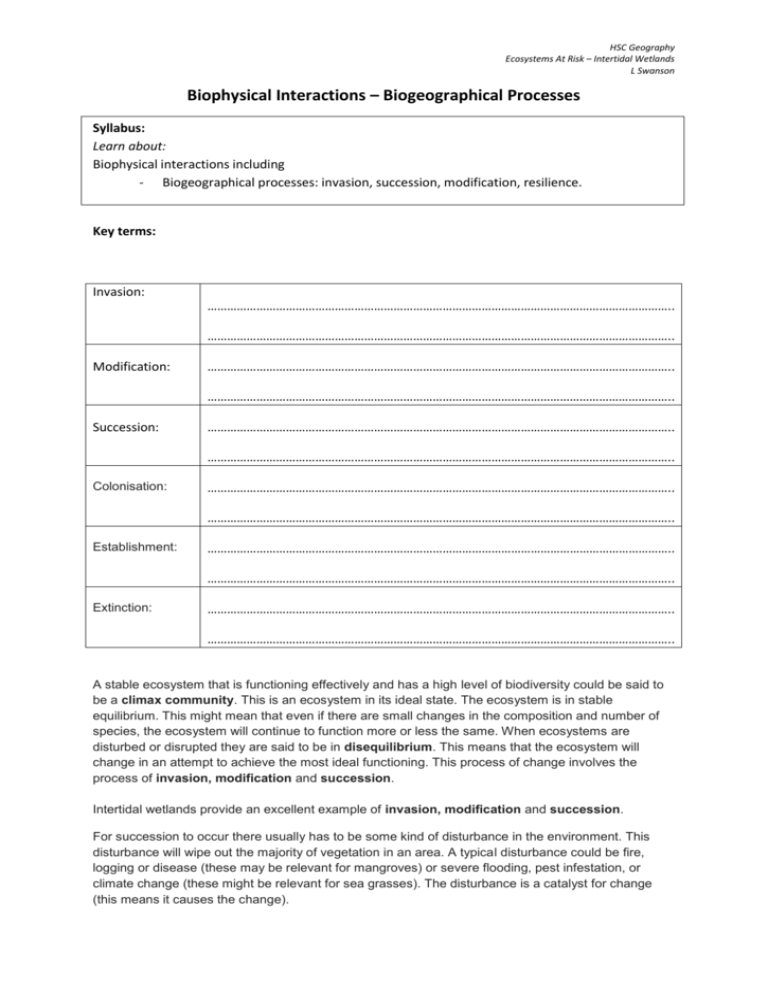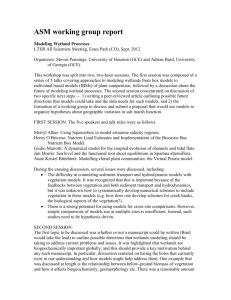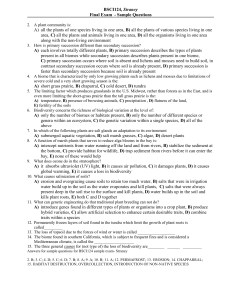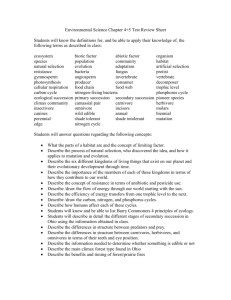File - HSIE Teachers
advertisement

HSC Geography Ecosystems At Risk – Intertidal Wetlands L Swanson Biophysical Interactions – Biogeographical Processes Syllabus: Learn about: Biophysical interactions including - Biogeographical processes: invasion, succession, modification, resilience. Key terms: Invasion: …………………………………………………………………………………………………………………………….. …………………………………………………………………………………………………………………………….. Modification: …………………………………………………………………………………………………………………………….. …………………………………………………………………………………………………………………………….. Succession: …………………………………………………………………………………………………………………………….. …………………………………………………………………………………………………………………………….. Colonisation: …………………………………………………………………………………………………………………………….. …………………………………………………………………………………………………………………………….. Establishment: …………………………………………………………………………………………………………………………….. …………………………………………………………………………………………………………………………….. Extinction: …………………………………………………………………………………………………………………………….. …………………………………………………………………………………………………………………………….. A stable ecosystem that is functioning effectively and has a high level of biodiversity could be said to be a climax community. This is an ecosystem in its ideal state. The ecosystem is in stable equilibrium. This might mean that even if there are small changes in the composition and number of species, the ecosystem will continue to function more or less the same. When ecosystems are disturbed or disrupted they are said to be in disequilibrium. This means that the ecosystem will change in an attempt to achieve the most ideal functioning. This process of change involves the process of invasion, modification and succession. Intertidal wetlands provide an excellent example of invasion, modification and succession. For succession to occur there usually has to be some kind of disturbance in the environment. This disturbance will wipe out the majority of vegetation in an area. A typical disturbance could be fire, logging or disease (these may be relevant for mangroves) or severe flooding, pest infestation, or climate change (these might be relevant for sea grasses). The disturbance is a catalyst for change (this means it causes the change). HSC Geography Ecosystems At Risk – Intertidal Wetlands L Swanson There are two types of succession: primary succession and secondary succession. Primary succession is when plants and animals move into an area that has no soils (e.g. after a volcanic eruption). Secondary succession is when plants and animals move into an area that has soils which previously supported vegetation (e.g. in the case of a cyclone, or flood). The process of succession in intertidal wetlands (generally secondary succession): Sea grass Sea grasses begin to establish themselves in small amounts of sediment. The growing seagrass captures moving sediment moving around in the water. It also slows water velocity allowing sediment to deposit. Through this process the sediment stabilises. The increase in sediment allows more seagrass to grow. This is the process of invasion. Mudflats As more and more sediment builds up, the area develops into mudflats. Organisms associated with mudflats move into the area. This includes bacteria, molluscs, worms, crustaceans and wading birds. Their activities change the composition of the soil by altering sediment through burrowing. The wastes (excrement) of these organisms add nutrients to the soil. Mangroves Above the level of the mudflats, mangrove begin to develop in the shallower water. The roots of the mangroves further stabilise soils and in time the soil levels increase. This results in less tidal movement in the area where the mangroves grow. Salt marsh Salt marshes develop in the salty soil behind the mangrove. Specialised grasses grow in the salt marsh. There are high levels of biodiversity in the salt marsh, and nutrient cycling is extremely productive in these areas. Snails, worms and insects are often found in the salt marsh areas. HSC Geography Ecosystems At Risk – Intertidal Wetlands L Swanson The process of succession in Intertidal wetlands No plants Wastes add nutrients to the soil Mangroves develop in shallow water Tidal movement is reduced Salt marsh develops in salty soil Nutrient cycling is high Casuarina grow furthest from the water Sea grasses begin to establish Organisms change the composition of soil Immediately follows some kind of disturbance Seagrass captures sediment Sediment stabilises Mangrove roots further stabilise soil Sediment build up develops into mudflats Reeds are found behind the salt marsh ……………………………………………………………………… …………………………………………………………………….. …………………………………………………………………….. …………………………………………………………………….. ……………………………………………………………………… ……………………………………………………………………… …………………………………………………………………….. …………………………………………………………………….. …………………………………………………………………….. ……………………………………………………………………… ……………………………………………………………………… …………………………………………………………………….. …………………………………………………………………….. …………………………………………………………………….. ……………………………………………………………………… HSC Geography Ecosystems At Risk – Intertidal Wetlands L Swanson ……………………………………………………………………… …………………………………………………………………….. …………………………………………………………………….. …………………………………………………………………….. ……………………………………………………………………… ……………………………………………………………………… …………………………………………………………………….. …………………………………………………………………….. …………………………………………………………………….. ……………………………………………………………………… ……………………………………………………………………… …………………………………………………………………….. …………………………………………………………………….. …………………………………………………………………….. ………………………………………………………………………







